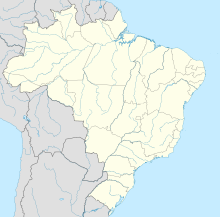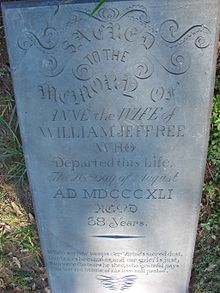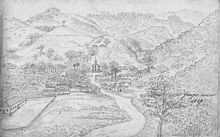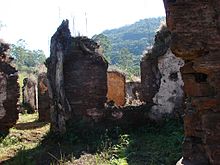289:
29:
330:
244:
280:) was responsible for the slaves, including their food, clothing, housing and discipline. Women slaves were employed above ground, mainly in washing the gold-bearing sand. Although Hasenclever wrote that Gongo Soco had 650 slaves in 1839, probably not all the black workers were slaves as he thought. There would have been free blacks working with the slaves, doing the same work but for pay. Another source gives the total in 1838 as 413 slaves, 148 Europeans and 190 Brazilians, totalling 751 people. Yet another source estimates that in 1840 there were 500 slaves, 200 Brazilian free workers and 51 Europeans. A doctor and a priest served all the workers, including slaves.
378:, and could produce about 7 million tons annually. In 2011 Vale said it could extend operations at the mine for a few more years, but was preparing to complete the project, with the transfer of 350 employees to other units. Vale said that high extraction costs and the low price of ore made operations uneconomical. In April 2016 it was announced that Vale was closing the Gongo Soco mine at the end of the month and laying off 90 employees. Production had dropped from about 6 million tons per year to about 4 million. The chief executive said he expected the workers would be relocated to other Vale units.
57:
232:
from the side galleries using drills and sledgehammers were hoisted by a simple winch and transported by wagon to a grinding mill. One black slave could easily push two wagons. The deposits at Gongo Soco were in weak rock formations, so large tree trunks from a forest 6 miles (9.7 km) away were needed to prop up the gallery ceilings. The mine had a large drainage pump driven by a water wheel, which also drove the grinding mills. The water was pumped up 330 feet (100 m), and was used to power a sawmill lower down the slope.
50:
261:
him there were four captains, eight officers and eighty
British miners who were assisted by 650 slaves owned by the Imperial Brazilian Mining Association. Each English miner received a yearly wage of £80, paid in monthly instalments. Many of the Cornish workers brought their families with them, encouraged to do so by the mine captain
317:, and used the fields or their houses for prayer and study meetings. Often they grew flowers and vegetables in their gardens from seeds brought from Cornwall. After the mine closed in 1856 some of the Cornish miners went back to Cornwall while some found work in other Brazilian mines such as those operated by the
312:
A company store sold a range of household goods. There was a market every
Saturday where the miners could buy chickens, eggs, fruit and vegetables. Some miners hired a local woman as a cook. The mine had a good library. There was a Catholic church for the slaves and Brazilians, and an Anglican church
260:
and used
Brazilians and slaves for unskilled work. The climate was considered healthy, with temperatures from 45 to 85 °F (7 to 29 °C). At first the mine had a superintendent, two mine captains and 31 miners and artisans. In 1839 the mine director received an annual salary of £3,500. Under
205:
and by less skilled
Brazilian labourers and slaves. Machinery powered by a water wheel and a steam engine was used to pump out the mine, operate the lifts, and operate the grinding mills where the gold was separated from the ore. The mine was closed when the gold ran out, but was later reopened as an
373:
Gongo Soco was abandoned until it was acquired in 1986 by Mineração
Socoimex, which maintained the remains of the former gold mine. On 11 May 2000 CVRD (Vale) acquired full control of Socoimex, which was extracting and selling iron ore from the Gongo Sôco Mine. The mine had proven reserves of about
231:
A steam engine above the mine shaft turned a double wheel that drove a long chain to haul up containers of ore and lower down logs. The main corridors were about 6 feet (1.8 m) high and contained iron rails on which wagons were pushed for about 200 yards (180 m). Loads of gravel extracted
223:
A Bitencourt prospector found gold in a stream that cuts through the region in 1745. The land was later inherited by João
Baptista Ferreira de Souza Coutinho, Baron of Catas Altas. He sold it to the Imperial Brazilian Mining Association, based in Cornwall, England, for £79,000 in 1825. The company
352:
It has been conjectured that the house of the Baron of Catas Altas covered 1,000 square metres (11,000 sq ft), assuming it was one story high. Near Sector 1 there is a chimney 5.2 metres (17 ft) high and 0.6 metres (2 ft 0 in) wide. Along the road to the right there is a
340:
There are two sets of ruins from the old Gongo Soco mine. Sector 1 contains the mine itself and its industrial structures. Sector 2, some distance away, holds the housing and infrastructure of the former village. According to the 1931 census the village had 30 stone houses along a 1.5 kilometres
235:
The mine had nine grinding mills, each with 12–24 wooden hammers with iron heads weighing 150 to 200 kilograms (330 to 440 lb). The gravel from the mine was placed in an iron container, then pounded into dust by the hammers, which were driven by a wooden wheel. The dust was washed from the
227:
A German visitor, Ernst
Hasenclever, visited the mine in 1839, when Gongo Soco was the largest gold mine in Brazil. The mine had a smithy where all the tools and instruments need for the mine were made, and a large 3-story warehouse holding provisions that also served as housing for the English
239:
In 1839 a record of 1,900 kilograms (4,200 lb) of gold was extracted. However, the machinery was not powerful enough to reach the deeper veins. Only 29 kilograms (64 lb) were produced in 1856, and the mine was closed. Later gold extraction was replaced by iron mining.
228:
miners. There was a hospital, which looking like a barracks to
Hasenclever. The hospital building was carefully planned, with central corridors, large rooms with two windows each and up to eight beds, and a sophisticated ventilation system to avoid humidity in the basement.
296:
A village grew up about 0.5 miles (0.80 km) from the mine in the wooded valley of the Gongo Soco River. The single-story buildings surrounded a church among banana trees. The former home of the Baron of Catas Altas was occupied by the superintendents of the mine. The
652:
236:
container by a fast current of water running through a cloth-lined trough. The heavy gold fell into the cloth, while lighter elements were washed out at the end. The cloth was then washed to remove the gold dust. The work continued day and night.
214:
The origins of the name "Gongo Soco" are obscure. One version is that when there was a theft in the mine a gong was sounded, but nobody listened. Another is that a slave from the Congo was found squatting ("soco") while burying a gold deposit.
341:(0.93 mi) road. It included the Cemitério dos Ingleses, where the British workers were buried, and where ten tombstones have been found with English inscriptions. There are traces of a hospital and two churches, one
660:
224:
converted the alluvial gold extraction operation into mechanised underground mining and gold extraction. From 1826 to 1856 the mine produced over 12,000 kilograms (26,000 lb) of gold.
675:
288:
28:
681:
329:
108:
305:
was a large building where the company commissioner would hold parties on
Saturday evenings. Concerts and dances were also arranged at the
753:
696:
314:
732:
301:
housed the director and first commissioner, and their families, and also held the mine's administrative and accounting offices. The
309:. The slaves lived apart from the Cornish to avoid contact and friction. Henwood opened a school for the children of the slaves.
353:
stone wall almost 60 metres (200 ft) long ending in an arched gateway, presumably erected to mark the visits of emperors
318:
653:"Com Gongo Soco fechada, Nozinho e prefeito de Barão pedem agilidade em liberação de outros projetos mineradores"
619:
680:(in Portuguese), IEPHA: Instituto Estadual do Patrimônio Histórico e Artístico de Minas Gerais, archived from
49:
787:
782:
243:
265:. They were on 3–5 year contracts, so there was constant contact with Cornish mining communities such as
792:
620:"Ernst Hasenclever em Gongo-Soco: exploração inglesa nas minas de ouro em Minas Gerais no século XIX"
362:
182:
713:
262:
8:
738:
797:
358:
346:
78:
634:
361:
in 1881. The ruined arch is covered by a fig tree. To the left is what the traveller
354:
537:
535:
533:
531:
529:
527:
398:
396:
394:
392:
390:
433:
431:
429:
427:
425:
423:
408:
595:
524:
342:
387:
420:
198:
776:
638:
123:
110:
194:
88:
583:
731:
712:
601:
571:
541:
247:
Gravestone of Anne, wife of
William Jeffree, who died in 1841 aged 38
752:
674:
437:
414:
402:
375:
257:
202:
270:
266:
201:
in the mid-19th century. It was worked by skilled miners from
33:
The old Gongo Soco mine in 1839, sketch by Ernst Hasenclever
651:
589:
734:
Mina de Gongo Soco, em Barão de Cocais, encerra atividades
695:
577:
206:
iron ore mine. Recently the iron mine was also closed.
466:
464:
462:
460:
458:
547:
500:
488:
559:
512:
476:
455:
443:
774:
737:(in Portuguese), 22 April 2016, archived from
659:(in Portuguese), 28 April 2016, archived from
313:for the Protestants. Many of the Cornish were
273:through miners travelling to and from Brazil.
27:
602:Mina de Gongo Soco ... encerra atividades
542:Gongo Soco – The Cornish in Latin America
438:Ruínas do Gongo Soco – DescubraMinas.com
415:Conjunto de ruínas do Gongo Soco – IEPHA
403:Conjunto de ruínas do Gongo Soco – IEPHA
328:
287:
242:
775:
365:says would have been a dressing room.
276:Hasenclever said a "black inspector" (
256:The company hired skilled miners from
617:
565:
553:
518:
506:
494:
482:
470:
449:
13:
701:(in Portuguese), Vale, 15 May 2000
319:Saint John d'El Rey Mining Company
56:
14:
809:
16:Gold mine in Minas Gerais, Brazil
677:Conjunto de ruínas do Gongo Soco
618:Alves, Débora Bendocchi (2014),
193:was a gold mine in the state of
55:
48:
590:Com Gongo Soco fechada ... 2016
374:75 million tons of high grade
1:
627:Hist. cienc. saude-Manguinhos
578:CVRD Acquired SOCOIMEX – Vale
760:(in Portuguese), SENAC MINAS
718:The Cornish in Latin America
368:
218:
209:
7:
10:
814:
610:
283:
251:
197:, Brazil, to the east of
178:
173:
165:
157:
152:
144:
139:
102:
94:
84:
74:
43:
38:
26:
381:
324:
124:19.964167°S 43.598056°W
754:"Ruínas do Gongo Soco"
720:, University of Exeter
698:CVRD Acquired SOCOIMEX
363:Richard Francis Burton
337:
293:
248:
129:-19.964167; -43.598056
332:
291:
246:
788:Iron mines in Brazil
783:Gold mines in Brazil
684:on 16 September 2016
663:on 24 September 2016
263:William Jory Henwood
315:Wesleyan Methodists
292:The village in 1839
120: /
23:
741:on 20 October 2018
338:
294:
249:
21:
758:DescubraMinas.com
629:(in Portuguese),
188:
187:
805:
793:Cornish diaspora
768:
767:
765:
749:
748:
746:
728:
727:
725:
709:
708:
706:
692:
691:
689:
671:
670:
668:
648:
647:
645:
624:
605:
599:
593:
587:
581:
575:
569:
563:
557:
551:
545:
539:
522:
516:
510:
504:
498:
492:
486:
480:
474:
468:
453:
447:
441:
435:
418:
412:
406:
400:
135:
134:
132:
131:
130:
125:
121:
118:
117:
116:
113:
59:
58:
52:
31:
24:
20:
813:
812:
808:
807:
806:
804:
803:
802:
773:
772:
771:
763:
761:
744:
742:
723:
721:
704:
702:
687:
685:
666:
664:
643:
641:
622:
613:
608:
600:
596:
588:
584:
576:
572:
564:
560:
552:
548:
540:
525:
517:
513:
505:
501:
493:
489:
481:
477:
469:
456:
448:
444:
436:
421:
413:
409:
401:
388:
384:
371:
327:
286:
254:
221:
212:
128:
126:
122:
119:
114:
111:
109:
107:
106:
79:Barão de Cocais
70:
69:
68:
67:
66:
65:
64:
60:
34:
17:
12:
11:
5:
811:
801:
800:
795:
790:
785:
770:
769:
750:
729:
710:
693:
672:
657:De Fato Online
649:
614:
612:
609:
607:
606:
594:
582:
570:
558:
546:
523:
511:
509:, p. 7–8.
499:
497:, p. 8–9.
487:
475:
454:
442:
419:
417:, p. 1–2.
407:
385:
383:
380:
370:
367:
345:and the other
326:
323:
285:
282:
278:Negerinspektor
253:
250:
220:
217:
211:
208:
199:Belo Horizonte
186:
185:
180:
176:
175:
171:
170:
167:
163:
162:
159:
155:
154:
150:
149:
146:
142:
141:
137:
136:
104:
100:
99:
96:
92:
91:
86:
82:
81:
76:
72:
71:
62:
61:
54:
53:
47:
46:
45:
44:
41:
40:
36:
35:
32:
15:
9:
6:
4:
3:
2:
810:
799:
796:
794:
791:
789:
786:
784:
781:
780:
778:
759:
755:
751:
740:
736:
735:
730:
719:
715:
711:
700:
699:
694:
683:
679:
678:
673:
662:
658:
654:
650:
640:
636:
632:
628:
621:
616:
615:
603:
598:
591:
586:
579:
574:
567:
562:
556:, p. 12.
555:
550:
543:
538:
536:
534:
532:
530:
528:
520:
515:
508:
503:
496:
491:
484:
479:
472:
467:
465:
463:
461:
459:
451:
446:
439:
434:
432:
430:
428:
426:
424:
416:
411:
404:
399:
397:
395:
393:
391:
386:
379:
377:
366:
364:
360:
356:
350:
348:
344:
336:
333:Ruins of the
331:
322:
320:
316:
310:
308:
304:
300:
290:
281:
279:
274:
272:
268:
264:
259:
245:
241:
237:
233:
229:
225:
216:
207:
204:
200:
196:
192:
184:
181:
177:
172:
168:
164:
160:
156:
151:
147:
143:
138:
133:
105:
101:
97:
93:
90:
87:
83:
80:
77:
73:
51:
42:
37:
30:
25:
19:
762:, retrieved
757:
743:, retrieved
739:the original
733:
722:, retrieved
717:
714:"Gongo Soco"
703:, retrieved
697:
686:, retrieved
682:the original
676:
665:, retrieved
661:the original
656:
642:, retrieved
630:
626:
597:
585:
573:
568:, p. 9.
561:
549:
521:, p. 8.
514:
502:
490:
485:, p. 7.
478:
473:, p. 5.
452:, p. 2.
445:
410:
405:, p. 1.
372:
357:in 1831 and
351:
339:
334:
311:
306:
302:
298:
295:
277:
275:
255:
238:
234:
230:
226:
222:
213:
195:Minas Gerais
190:
189:
115:43°35′53.0″W
112:19°57′51.0″S
89:Minas Gerais
18:
335:Casa Grande
307:Casa Grande
303:Casa Grande
299:Casa Grande
127: /
103:Coordinates
777:Categories
566:Alves 2014
554:Alves 2014
519:Alves 2014
507:Alves 2014
495:Alves 2014
483:Alves 2014
471:Alves 2014
450:Alves 2014
191:Gongo Soco
148:Gold, iron
140:Production
63:Gongo Soco
22:Gongo Soco
798:Vale S.A.
764:12 August
745:12 August
724:12 August
705:12 August
688:12 August
667:12 August
644:12 August
639:0104-5970
369:Iron mine
219:Gold mine
210:Etymology
169:1826–1856
376:hematite
359:Pedro II
347:Anglican
343:Catholic
258:Cornwall
203:Cornwall
145:Products
75:Location
39:Location
611:Sources
355:Pedro I
284:Village
271:Redruth
267:Gwennap
252:Workers
179:Company
153:History
98:Country
95:Country
637:
166:Active
158:Opened
633:(1),
623:(PDF)
382:Notes
325:Ruins
174:Owner
85:State
766:2016
747:2016
726:2016
707:2016
690:2016
669:2016
646:2016
635:ISSN
269:and
183:Vale
161:1826
779::
756:,
716:,
655:,
631:21
625:,
526:^
457:^
422:^
389:^
349:.
321:.
604:.
592:.
580:.
544:.
440:.
Text is available under the Creative Commons Attribution-ShareAlike License. Additional terms may apply.




